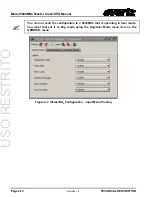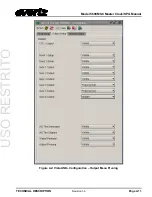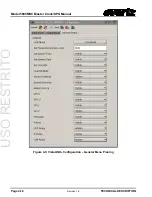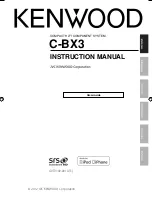
Model 5600MSC Master Clock/SPG Manual
TECHNICAL DESCRIPTIONOPERATION
Revision 1.6
Page
3-71
3.8.
OPERATING WITH GLOBAL POSITIONING SYSTEM LOCK (G Option)
When the GPS option is installed, the 5600MSC can be both frequency and time locked to the Global
Positioning system (GPS). The following section described an overview of the GPS system and the
operation of the 5600MSC when it is locking to the GPS satellites. See section 2.4 for information
about installing the GPS antenna and connecting it to the 5600MSC.
3.8.1. The Global Positioning System Overview
The Global Positioning System (GPS) is a satellite based navigation system operated and maintained
by the U.S. Department of Defense. When fully implemented, the GPS will consist of 24 satellites
providing worldwide 24 hour, coverage. Originally conceived for military needs, the GPS has a broad
array of civilian applications including timing, surveying, marine, land, aviation and vehicle navigation.
GPS, the most accurate technology available for marine and land navigation is emerging as the
technology of choice in timing applications including site and network synchronization.
As a satellite system, the GPS is immune from the limitations of land based systems previously
available. By computing the distance to GPS satellites orbiting the earth, a GPS receiver can calculate
an accurate position. This process is called satellite ranging. A two-dimensional position calculation
requires three satellite ranges. A three-dimensional position calculation, including altitude requires four
satellite ranges. GPS receivers can also provide precise time, speed, and course measurements.
3.8.2. GPS
Lock
Operation
Once the GPS has been locked and in steady state condition for longer then 20 minutes the
5600MSC's frequency reference is locked to within 100ns of the GPS system time reference.
If the GPS head is disconnected, the frequency reference within the 5600MSC may drift very slowly
over time. (The figures provided below are assuming the unit is kept switched on and is maintained in
the same operating environment). The maximum frequency drift of the 5600MSC's frequency reference
is less 0.04 Hz at subcarrier frequency after a day of the GPS receiver being disconnected. The drift
will be less then 0.3 Hz if the GPS receiver was disconnected or obscured from the sky for 1 year.
Upon reconnecting the GPS antenna there will be a very smooth transition of the 5600MSC’s frequency
reference back to the GPS frequency. This transition is very smooth and gradual with no non-linear
jumps. The re-lock will take less then 40 minutes after an unspecified period of time (i.e. 1 year or
more) of the GPS receiver being disconnected or obscured from the sky. If the GPS head is removed
for 5 min and then returned, the unit will take nominally less then 5 minutes to return fully lock to GPS
receiver. If the GPS receiver is removed for 15 min and then returned, the unit will take nominally less
then 20 minutes to return fully locked to the GPS receiver.
USO
RESTRITO
















































